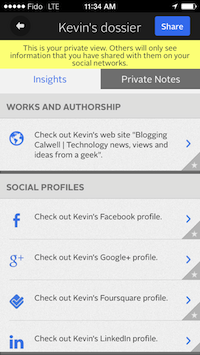A Refreshing Context
This week, a number of contextual horizons have been opened for me. First, I was given the chance to read (and review) a pre-release version of Robert Scoble’s book, Age of Context. I’m reading it rather slowly, but I will get there. Along the way, a column on I, Cringly introduced me to Refresh, a simple contextual iOS application that gathers information on contacts from multiple sources based on information it finds in your calendar. Context is really starting to pick up in applications, and I expect we’ll hear much more about this idea in the coming months and years.
Refresh is a great idea; it uses the information you have available (social media accounts, contacts, connections) and other data that may be freely available on the Internet to build what they call a “Dossier” on a person. Refresh can provide quite a few details from pictures to the very personal details hidden in less obvious social media posts. What results is probably the most complete look at a person you can get without actually meeting them [1].
And, the context may be a buzzword, but if you’re a programmer or application designer, context is hard. Imagine a simple relative test to figure out how many people in your immediate area prefer Heinz ketchup over that of a no-name brand. To get this kind of relevant data, you would have to have the opt-in of a large enough sample or be able to pry the details out of a database somewhere. If you don’t have enough people or data involved, there is no context. That’s not even necessarily useful information [2].
Consider a more useful test; Get the pricing for a 500ml container of Heinz ketchup from every local supermarket and link you to a price-match compatible advertisement you can show at the counter. This way, the context data gives our users the ability to shop at one supermarket, yet be sure that the price they pay there is always the lowest in the immediate market. Does this tool exist in the Toronto area? Not that I know of, because context is hard.
Now, back to Refresh. This tool is great for a person with whom you’re connected or has a great deal of public information available. The trouble comes in when you search for the rest of the people you know. You’ll get almost nothing, and this is probably most of the people you know. Less of your contacts will be like me, requiring a more exhaustive search than a few social networks.
But, what about a contextual application that is not moored the limitations of a few social media sites? To find out more to know more about them, take a piece of information [3] and expand the search to possible mentions on any social media site, check for domains I own and parse WHOIS data for email addresses and or physical addresses, use that information to crawl publicly available websites for phone numbers. Reverse search addresses for companies or people that may have lived there. In essence, use the entire Internet as a database for an identity search, regardless of your connection to that person.
That kind of application is a refreshing use of context.


